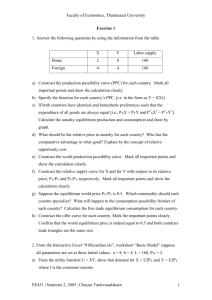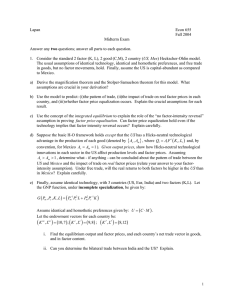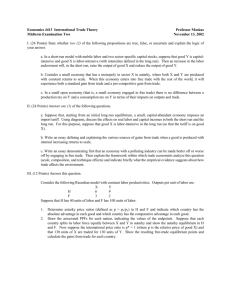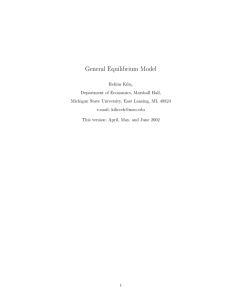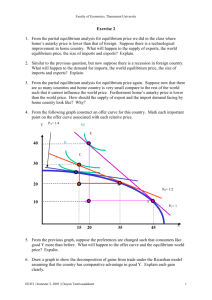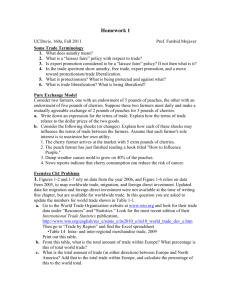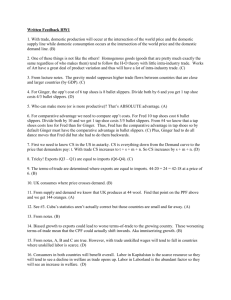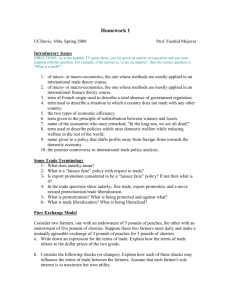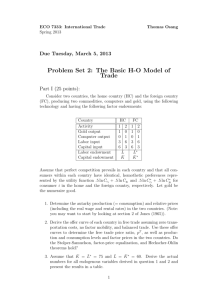Economics 433 Exam 1 Fall 1997 Part I: Short Answer Questions
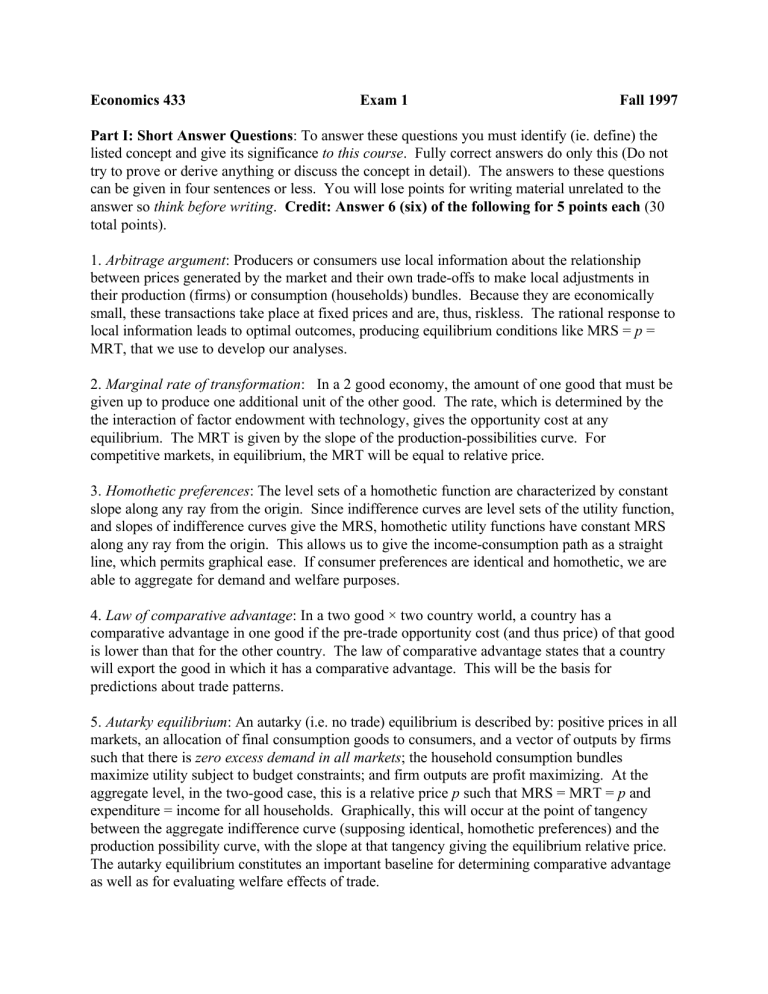
Economics 433 Exam 1 Fall 1997
Part I: Short Answer Questions : To answer these questions you must identify (ie. define) the listed concept and give its significance to this course . Fully correct answers do only this (Do not try to prove or derive anything or discuss the concept in detail). The answers to these questions can be given in four sentences or less. You will lose points for writing material unrelated to the answer so think before writing . Credit: Answer 6 (six) of the following for 5 points each (30 total points).
1. Arbitrage argument : Producers or consumers use local information about the relationship between prices generated by the market and their own trade-offs to make local adjustments in their production (firms) or consumption (households) bundles. Because they are economically small, these transactions take place at fixed prices and are, thus, riskless. The rational response to local information leads to optimal outcomes, producing equilibrium conditions like MRS = p =
MRT, that we use to develop our analyses.
2. Marginal rate of transformation : In a 2 good economy, the amount of one good that must be given up to produce one additional unit of the other good. The rate, which is determined by the the interaction of factor endowment with technology, gives the opportunity cost at any equilibrium. The MRT is given by the slope of the production-possibilities curve. For competitive markets, in equilibrium, the MRT will be equal to relative price.
3. Homothetic preferences : The level sets of a homothetic function are characterized by constant slope along any ray from the origin. Since indifference curves are level sets of the utility function, and slopes of indifference curves give the MRS, homothetic utility functions have constant MRS along any ray from the origin. This allows us to give the income-consumption path as a straight line, which permits graphical ease. If consumer preferences are identical and homothetic, we are able to aggregate for demand and welfare purposes.
4. Law of comparative advantage : In a two good × two country world, a country has a comparative advantage in one good if the pre-trade opportunity cost (and thus price) of that good is lower than that for the other country. The law of comparative advantage states that a country will export the good in which it has a comparative advantage. This will be the basis for predictions about trade patterns.
5. Autarky equilibrium : An autarky (i.e. no trade) equilibrium is described by: positive prices in all markets, an allocation of final consumption goods to consumers, and a vector of outputs by firms such that there is zero excess demand in all markets ; the household consumption bundles maximize utility subject to budget constraints; and firm outputs are profit maximizing. At the aggregate level, in the two-good case, this is a relative price p such that MRS = MRT = p and expenditure = income for all households. Graphically, this will occur at the point of tangency between the aggregate indifference curve (supposing identical, homothetic preferences) and the production possibility curve, with the slope at that tangency giving the equilibrium relative price.
The autarky equilibrium constitutes an important baseline for determining comparative advantage as well as for evaluating welfare effects of trade.
6. Immiserizing growth : This refers to the possibility that economic growth (i.e. improvement in technology or factor accumulation) may lower the welfare of a large trading economy. Since the result turns on an adverse terms-of-trade effect, it is not possible for a small economy, or as a result of import-biased growth for a large economy. Example of comparative static analysis.
7. Transfer problem : Refers to the question of whether a country which makes a transfer to another country will suffer a secondary burden (i.e. will lose from a deterioration in its terms-oftrade as well as the lost resources that are tranferred directly). Example of comparative static analysis.
8. Excess demand : Excess demand for good j is given by ( D j
- S j
). Because non-zero excess demand is only possible with trade (i.e. excess demand in autarky equilibrium must be zero), excess demand is really import demand. Because the excess demand summarizes all the trade relevant national information, it is an essential tool in analyzing international equilibrium.
9. Income-consumption line : This is the locus of consumption bundles demanded at constant relative prices and all positive levels of income. Thus, for a given relative price, p , the IC-line identifies all bundles where MRS = p . With homothetic preferences these are rays from the origin.
The intersection of the IC-line, defined relative to the relevant world price, with the national income line identifies bundles where MRS = p and income = expenditure.
10. Walras’ Law : This property of all general equilibrium systems states that the sum of the value of excess demands is always equal to zero. We use this condition in a number of ways. In particular we use is to select one good as a numeraire , allowing us to focus our attention on equilibrium in the other market.
Essay Information and Advice . Think carefully before answering. Write clearly and carefully.
To answer questions correctly you must prove any assertion you make. If you use a result developed in the class or in the text you must prove that result. The proof need not be graphical, but it must be analytically clear. If you do use a graphical analysis you must clearly explain all the relevant parts of the graphical apparatus. A clear, coherent, correct account of your argument must accompany graphical and or arithmetic argument. No credit will be given for a graph without supporting argument, no matter how correct . In the questions I will use the term
"neoclassical preferences" to denote preferences yielding utility functions that are: positive for positive amounts of both goods (and zero if consumption of either good is zero); increasing in both goods at a diminishing rate; and homothetic. All markets are taken to exist and to be perfectly competitive.
Part II: Essays/Problems –answer all [70 points total].
1. Imagine a world with only two countries, A and B , and two goods, X and Y . Suppose that the two countries share identical, increasing opportunity cost, aggregate production conditions.
Specifically, suppose that both countries production possibility curves take the form of identical quarter circles. Everyone in A prefers to consume X and Y in a constant ratio of 2:1, while everyone in B prefers to consume X and Y in a constant ratio of 1:2.
a. If both of these countries are initially in autarky, what will determine the autarky price of X relative to Y in each country? Illustrate and exposit your answer graphically. (5 points)
In autarky, with Leontief indifference curves, the relative price will be determined by the slope of the PPF at the equilibrium consumption point. The diagram shows the common
PPF and the two fixed share income-consumption lines. Thus, equilibrium in country B will occur where IC-line B cuts the PPF (i.e. point 1) and the relative price will be given
by the MRT at that point. Note, as a check on your intuition, that the autarky price in the country with a relatively strong preference for X (A) has a realtively higher autarky price of X (i.e the slope of the tangent at 2 is steeper than the slope of the tangent at 1).
b. Now suppose that trade is opened between these two countries. Use the law of comparative advantage to identify which country will export good X . Illustrate and exposit your answer graphically. [Hint: It will be easier to do this if you show both countries on the same graph.] (10 points)
The law of comparative advantage states that a country will have a comparative advantage in, and thus export, the good with the lower autarky relative price ratio. Thus, since, as we just showed in the answer to part a, country B has the lower price of X relative to Y, country B will have a comparative advantage in good X and is thus predicted to export good X.
c. Recalling that both countries consume goods in fixed quantities, for the country that imports X , draw a graph of its excess demand curve. Can this curve be downward sloping? Explain your answer. (5 points)
Even though demand for X is fixed for any constant level of income, production can shift.
Now, recall that E
X
(
D
X
( )
S
X
( ) )
. However, in this case, there is no consumption effect: Leontief preferences implies that there is no substitution effect and no income effect. Nonetheless, S
X
does rise as p rises and, since S
X
enters the definition of excess demand negatively, E
X
must be negatively related to p . That is, excess demand is downward sloping.
d. For either country (i.e. don’t do both, but identify which country you are analyzing), illustrate and explain the main components of the gains from trade. (5 points)
Consider country B. With Leontief preferences, at autarky, there are no consumption gains from trade. Substitution is not possible, so there is no substitution effect and the fall in the relative price of Y (the importable) does not translate into a different preferred bundle reflecting increased income at the new prices. However, the production effect, the shift from the initial equilibrium to point 3 does permit increase consumption of both goods, at point 1.
e. Now suppose that country A experiences a general improvement in the conditions of production such that it becomes 20 percent more efficient in producing any bundle of outputs. Illustrate and explain the effect of this change on the international market and the home market in A . [10 points]
The dotted line in the above picture illlustrates this situation. If prices remain constant,
A’s output of Y:X will increase at 1:1 (to point 4), but it’s demand will increase at 1:2 (to point 5). To illustrate using the above diagram of the world market, let’s focus on the market for X. There will be an excess demand for X (and an excess supply of Y). That is, for every relative price, the excess demand after the technology change will exceed that before the shock. Note that, in this case, the autarky price cannot change (i.e. the fixed ICline cuts the two PPCs at points of common slope), thus the excess demand curve rotates counter-clockwise about the autarky point, producing a new world price and quantity traded combination. Note, in particular, that the world price has risen, i.e. the terms of trade for country A (the X importing country) have deteriorated. Quantity traded has increased, but not by as much as would have been the case without the deterioration in the terms of trade. In A, the response to the ToT change involves both a production effect and an income effect (but not substitution effect).
2. A small island in the south Pacific (kind of near Australia) has a very peculiar economy. Half of the families own fruit trees, and nothing else; the other half own coffee bushes, and nothing else.
Since it is well-known, at least on this island, that a good meal requires both coffee and fruit, but that otherwise preferences are neoclassical (and are, in fact, identical across all the island’s households), an active trade between households grew up in autarky.
a. Use a graphical argument to show that there must be gains from trade between households in this economy. [5 points]
For convenience I have represented the assumption of common preferences by showing the two endowment points on the same indifference curve. The assumption of diminishing marginal rate of substitution means that consumers prefer mixtures of goods, so both types of household will gain by trading. Trade will produce a relative price between the household autarky prices. Because there must be a single relative price in the interhousehold market, and because preferences are identical and homothetic, both households will consume the same relative mix of goods. If, as drawn, household incomes are identical after trade, then each type of household will consume half of the economy’s endowment of each good.
b. Now suppose that trade is opened with a neighboring island, which also produces only fruit and coffee, but at prices different from those that obtain in our island under autarky. If both countries are large, illustrate the determination of post-trade prices. [5 points]
You must assert that one country (your choice, it isn’t specified in the question) has the relatively low autarky price of, say, food. Then, explaining that excess demand is downward sloping and the other country’s excess supply is upward sloping, show the determination of a world price at the intersection of these two curves.
c. Illustrate the components of the gains from inter-island trade for this case. [5 points]
Identical homothetic preferences means that we can aggregate across households to get an aggregate utility function. As shown here, autarky equilibrium occurs at point A. I have drawn the case where the Home island has a comparative advantage in food (i.e. the home islands autarky relative price is lower than the post-trade world price. As shown, even though production of F and C is fixed, the new consumption point made available by trade
(i.e. 2) lies strictly inside the better than set for this country. Alternatively, one can assert via homotheticity that the post-trade equilibrium must occur at the intersection of the post-trade income-consumption line and the post-trade national income line, and that this point must lie on a higher indifference curve (i.e. since 1 lies on the autarky indifference curve and 2 involves more of both goods than 1, 2 must imply a higer level of welfare).
Using this picture, it is easy to see that there is no production gain (since production cannot respond to changed prices). The substitution effect is the shift from A to 1 and the income effect is the shift from 1 to 2. Thus, the consumption effect is strictly positive, so there are gains from trade.
d. Must inter-island trade benefit everyone on the island? [ Reminder : no credit will be given for a simple yes or no, regardless of whether or not it is correct. You must explain your answer in terms of the model developed in this question.] [10 points]
Again, we suppose that the Home island has a comparative advantage in Food. That is, the post trade price of food is higher than the autarky (but with inter-household trade) price. Households that own only fruit trees must gain (i.e. they move from A to 2), but households that own only coffee bushes must lose relative to the inter-household trade/inter-island autarky equilibrium (i.e. they move from A to 1). Thus, while the island as a whole gains, only half the households on the island gain.
e. Suppose that the most popular person on the island says publicly that everyone should eat more fruit, and that this person is a real trend-setter. How will this affect the international terms of trade? [10 points]
We have assumed that the Home island is an exporter of food. The increased demand at any price, with fixed supply, will lower excess supply at any price. This will cause the
Home export supply curve to shift inward, resulting in an increase in the relative price of food. This is an improvement in the Home island’s terms of trade and deterioration in the terms of trade of the other island.
